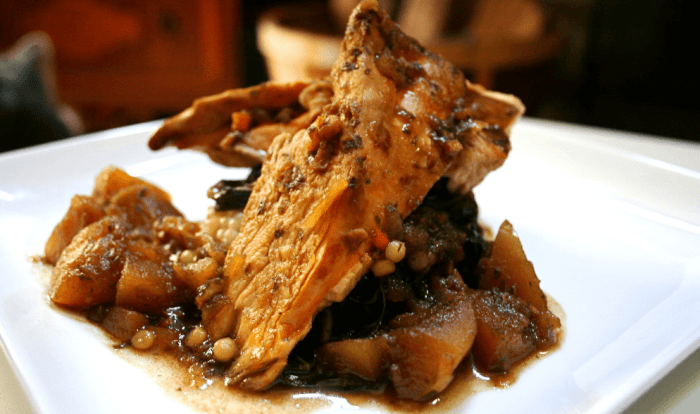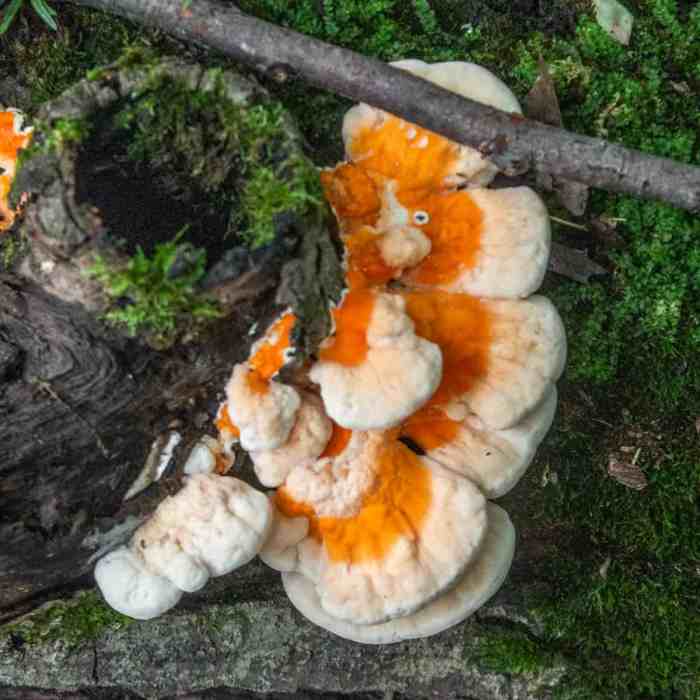
Chicken of the woods recipe, an exciting journey into the realm of culinary delights awaits. With its vibrant colors and unique texture, this mushroom holds a special place in the hearts of food enthusiasts. Embark on a culinary adventure as we explore its flavors, health benefits, and the art of foraging.
Chicken of the woods, a versatile culinary ingredient, graces our plates with its distinctive appearance and umami-rich taste. Its versatility shines in various cooking methods, from sautéing to grilling, unlocking a symphony of flavors.
Overview of Chicken of the Woods: Chicken Of The Woods Recipe

Chicken of the Woods (Laetiporus sulphureus) is a striking and delicious mushroom known for its bright orange color and meaty texture. Its distinctive appearance resembles that of a chicken’s flesh, hence its common name.
Historically, Chicken of the Woods has been a culinary delicacy for centuries. Ancient Romans and Greeks prized it for its unique flavor and medicinal properties.
Appearance
Chicken of the Woods typically grows in clusters on the sides of trees, especially oaks and beeches. It has a large, shelf-like cap that can range from 4 to 12 inches in diameter. The cap is covered in a layer of tiny, velvety pores, which give it a unique texture.
If you’re looking for a delicious and unique vegetarian meal, check out this chicken of the woods recipe . This mushroom has a meaty texture and a slightly sweet flavor, making it a great substitute for chicken in many dishes.
Texture
The texture of Chicken of the Woods is firm and meaty, similar to chicken flesh. When cooked, it becomes tender and juicy, making it a popular ingredient in vegetarian and vegan dishes.
Flavor
Chicken of the Woods has a mild, earthy flavor with hints of citrus and spice. It is often described as having a “chicken-like” taste, which makes it a versatile ingredient that can be used in a variety of dishes.
Recipe Variations

Chicken of the Woods is a versatile mushroom that can be prepared in a variety of ways to enhance its distinct flavor. From sautéing to grilling and roasting, the options are endless.
Each cooking method imparts a unique flavor profile, allowing you to experiment and find your favorite way to enjoy this delicious mushroom.
Sautéing, Chicken of the woods recipe
- Heat a skillet over medium heat and add butter or olive oil.
- Add the cleaned and sliced Chicken of the Woods and cook until browned and tender.
- Season with salt, pepper, and your favorite herbs.
- Serve as a side dish or use in tacos, sandwiches, or pasta.
Grilling
- Preheat your grill to medium heat.
- Brush the Chicken of the Woods with olive oil and season with salt and pepper.
- Grill for 5-7 minutes per side, or until tender and slightly charred.
- Serve as a grilled appetizer or use in kebabs.
Roasting
- Preheat your oven to 400°F (200°C).
- Toss the Chicken of the Woods with olive oil, salt, pepper, and any desired herbs.
- Spread the mushrooms on a baking sheet and roast for 15-20 minutes, or until tender and golden brown.
- Serve as a side dish or use in salads, soups, or stews.
Nutritional Benefits

Chicken of the Woods is not just a delicious mushroom; it’s also packed with essential nutrients that contribute to overall health and well-being. This vibrant mushroom is a rich source of vitamins, minerals, and antioxidants, making it a valuable addition to any diet.
Consuming Chicken of the Woods can provide the following nutritional benefits:
Vitamin D
- Chicken of the Woods is one of the few natural sources of vitamin D, which is crucial for bone health, immune function, and mood regulation.
- Regular consumption of this mushroom can help prevent vitamin D deficiency, which is common in many parts of the world.
Antioxidants
- Chicken of the Woods contains a variety of antioxidants, including ergothioneine and glutathione.
- These antioxidants protect cells from damage caused by free radicals, reducing the risk of chronic diseases such as cancer and heart disease.
Minerals
- This mushroom is also a good source of minerals, including potassium, phosphorus, and magnesium.
- Potassium supports healthy blood pressure, while phosphorus and magnesium contribute to bone health and energy production.
Nutritional Table
| Nutrient | Amount per 100g |
|---|---|
| Vitamin D | 10-25 IU |
| Ergothioneine | 12-15 mg |
| Glutathione | 2-3 mg |
| Potassium | 400-500 mg |
| Phosphorus | 100-150 mg |
| Magnesium | 20-30 mg |
Pairing and Accompaniments
Chicken of the Woods is a versatile mushroom that pairs well with a variety of dishes. Its meaty texture and earthy flavor make it a great addition to pasta, rice, and salads. It can also be grilled, roasted, or fried as a main course or side dish.
If you’re new to cooking with chicken of the woods, I recommend starting with a simple recipe like this chicken of the woods recipe . It’s easy to follow and only requires a few ingredients.
Here are some ideas for sauces, marinades, and seasonings that will enhance the flavor of Chicken of the Woods:
Sauces
- Creamy Alfredo sauce
- Garlic butter sauce
- Lemon-herb sauce
- Red wine reduction sauce
Marinades
- Italian herb marinade
- Soy sauce marinade
- Teriyaki marinade
- Honey-mustard marinade
Seasonings
- Salt and pepper
- Garlic powder
- Onion powder
- Paprika
Pairing Table
| Dish | Pairing Suggestions |
|---|---|
| Pasta | Creamy Alfredo sauce, garlic butter sauce, lemon-herb sauce |
| Rice | Soy sauce marinade, teriyaki marinade, honey-mustard marinade |
| Salads | Italian herb marinade, salt and pepper, garlic powder |
| Main Course | Red wine reduction sauce, paprika, onion powder |
| Side Dish | Garlic butter sauce, salt and pepper, garlic powder |
Foraging and Identification
Identifying Chicken of the Woods in its natural habitat requires a keen eye and an understanding of its distinctive features. This vibrant mushroom boasts a bright orange or yellow coloration, resembling a cluster of chicken combs. Its flesh is typically firm and white, exuding a pleasant, fruity aroma.
However, it’s crucial to note that there are lookalikes that share similar characteristics, such as the toxic Jack-o’-lantern mushroom.
Importance of Responsible Foraging
Responsible foraging practices are paramount when harvesting Chicken of the Woods. Avoid picking mushrooms from areas near roadsides, industrial sites, or where pesticides have been used. Always seek permission from landowners before foraging on private property. Additionally, it’s essential to leave some mushrooms behind for wildlife and to ensure the species’ longevity.
Identification Guide
Step 1: Color and ShapeCheck for a cluster of bright orange or yellow mushrooms with a chicken comb-like appearance.Step 2: Flesh and TextureExamine the flesh of the mushroom. It should be firm and white, not soft or slimy.Step 3: StemChicken of the Woods typically has a short, thick stem that is not deeply rooted in the ground.Step
4: SmellTake a whiff of the mushroom. It should have a pleasant, fruity aroma.Step 5: LookalikesBe aware of potential lookalikes, such as the Jack-o’-lantern mushroom, which has similar coloration but emits a pungent odor.Step 6: Consult an ExpertIf you’re uncertain about a mushroom’s identity, consult with an experienced mycologist or foraging guide for confirmation.
Last Point

Chicken of the woods recipe, a culinary treasure, leaves a lasting impression. Its nutritional value, diverse flavor profiles, and ease of preparation make it a must-try for mushroom lovers and culinary adventurers alike. So, gather your ingredients, embrace the flavors, and let chicken of the woods take you on a culinary expedition.
FAQ Guide
What is the best way to cook chicken of the woods?
Chicken of the woods is incredibly versatile and can be sautéed, grilled, roasted, or fried. Each method brings out different flavors and textures, so experiment to find your favorite.
Is chicken of the woods safe to eat raw?
No, chicken of the woods should not be consumed raw. Cooking destroys potential toxins and ensures its safe consumption.




